2009 Cadillac CTS-V vs. 2010 Jaguar XFR, 2010 Mercedes-Benz E63 AMG
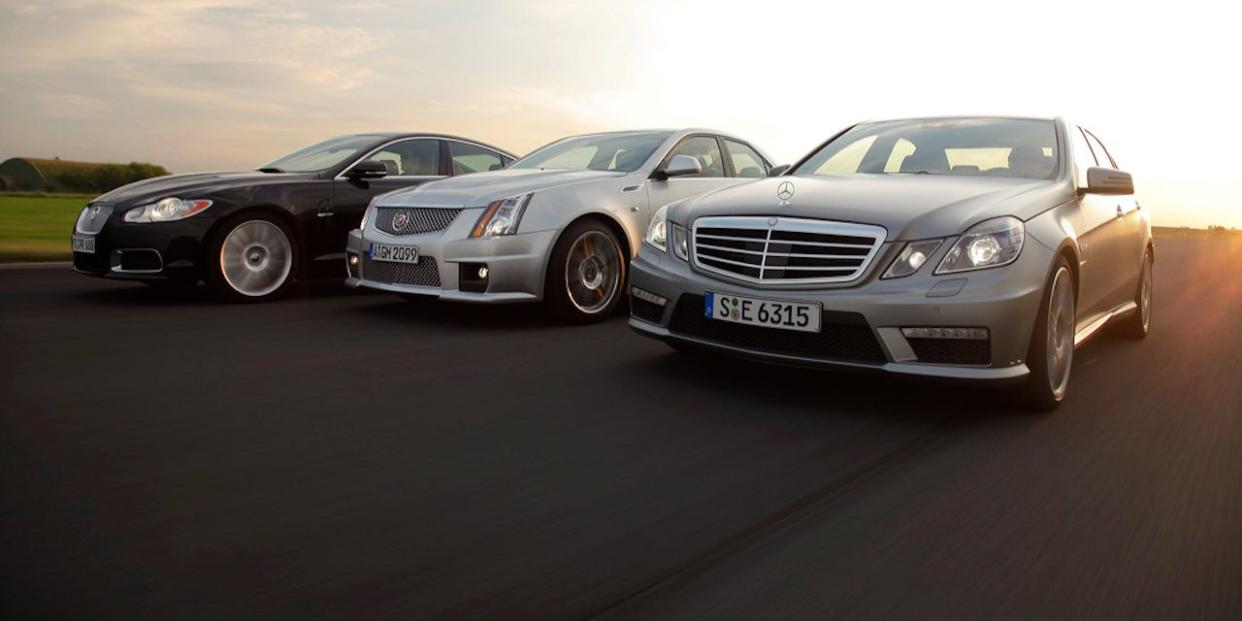


Under full-throttle acceleration, the Mercedes-Benz E63 AMG spews such a thunderous wail from its four exhaust pipes that usually cheerful southern Germans, apparently used to the softer sounds of airplanes taking off and landing at our runway testing site, called to complain about the noise. In Bavaria, it seems, it’s an unalienable right to leave your windows open and protest when the slightest clank disturbs an idyllic afternoon.
Truth is, we weren’t exactly behaving like ambassadors of goodwill in a foreign land. We blame the cars, all supersedans pumping out more than 500 horsepower each. Even the Jaguar XFR, rebelling against its tweedy British stereotype, was nearly as loud from the side of the road as the Benz.
The Cadillac CTS-V, perhaps in an extension of President Obama’s happy rhetoric about restoring our relationship with Europe, provoked no such ire from Germany’s greens, thanks to a soft-spoken exhaust made to meet European noise regulations. Even with the muted soundtrack, our usually home-team-loyal German correspondent quickly deemed the Cadillac to be the sportiest-feeling car of our trio and one that, at $67,345, undercuts the test’s second-priciest Jaguar by more than $12,500.
It will cost you about $8000 more than the Jag to start looking at the Mercedes; with optional carbon-ceramic brakes, 19-inch wheels, and some luxury accouterments, we estimate an as-tested price to surge past a hundred grand. Those brakes are available right now in Europe, but their U.S. arrival will be delayed a year reportedly due to short supplies, thus the estimate. Also to be determined are the E63’s U.S. fuel-economy ratings and, thus, the severity of its gas-guzzler tax. And that doesn’t include the stealth-fighter matte paint on our test unit, which will be found stateside on only the SLS supercar for the foreseeable future.
Despite the disparate window stickers, everything else—horsepower, weight, terrible fuel economy, even tire width—is nearly identical in this group. Even the acceleration to 100 mph ended up in a three-way tie. We wouldn’t dare call any of these cars a loser, but still, there must be a winner.
The curvaceous sheetmetal of the XFR is not a sight you see often in Germany, where the roads seem populated by either squared-off autobahn cruisers or jelly-bean shapes from Italy and France. But even alone on the road without the blocky contrasts, the Jaguar looks good from every angle. Special 20-inch wheels, a tweaked body kit, and R badges are the equivalent of adding cuff links, suspenders, and sock garters to the standard XF’s Savile Row tailoring.
The inside is easy not just on the eyes but the hands as well: The seats are covered in soft two-tone leather, as is the dash, which is also accented with aluminum trim, and the faux-suede headliner is as plush as any we’ve seen. Unfortunately, some of the gilded trim pieces weren’t lined up well, penalizing the Brit’s score for fit and finish. But, hey, at least the electronics worked flawlessly.
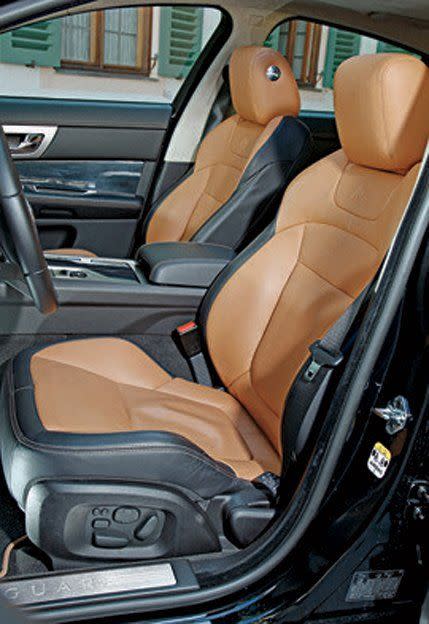
We’re still slightly annoyed by the XFR’s multimenu touch screen, which takes time and attention to switch among radio, navigation, and climate controls. And the rotary shift knob, while pretty, is still fussy in operation. But secondary buttons that toggle stability and traction control, winter mode, and dynamic mode are all placed nearby, clearly labeled and easy to use.
The ride is the softest of the three, and the XFR exhibits the most body roll. Predictably, the Jag finished last in skidpad grip and lane-change performance. But while the XFR floats over smooth roads, there is harshness when the suspension reacts to bumps, resulting in a chassis that is neither as compliant as the Cadillac’s nor as responsive as the Benz’s. Dynamic mode, which stiffens the adjustable dampers on the Bilstein shock absorbers, helps control body roll with minimal degradation in ride quality.
Still, the XFR lacks sharpness in its reactions to driver inputs. The brake pedal is soft and numb, so any attempt to gently reduce speed is met with an imprecise application of braking power that sends the heads of passengers bobbing toward the windshield. On blurry autobahn runs, the Jaguar is upset more by undulations in the road than the others and requires more corrective steering input to stay on course.
The Jag gives up more than a liter of displacement to its two rivals, but the 32-valve, 5.0-liter V-8 makes up for its relative size deficiency with a supercharger and direct injection, resulting in 510 horsepower and 461 pound-feet of torque. Quarter-mile performance is just 0.1 second behind the Benz’s, and in fact, the XFR pulls ahead of the E63 on the way to 150 mph despite having the lowest horsepower rating and the greatest curb weight here. The Jag also stopped shortest in braking from 70 mph. If the Jaguar is found lacking in sportiness in this accomplished group, it’s only by a few increments. The engine note is inspiring, and the six-speed automatic changes gears quickly and smoothly. It’s just that the Mercedes shifts even more quickly and sounds better doing it. Ditto for the manumatic paddle shifters, which are small and plastic in the XFR. They function fine, but the larger metal flaps that work the E63’s gearbox are more appropriate.
____________________________________________________
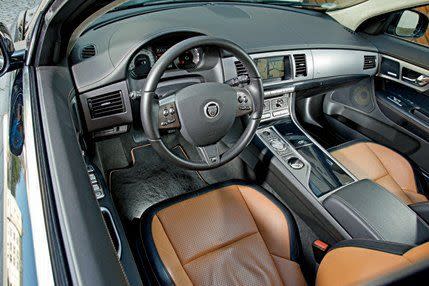
Leather covers most everything but the headliner, with contrasty stitching worthy of Savile Row. The lighter tone is appropriately called “London Tan.”
____________________________________________________
Fortunately, the Jaguar does not lack for comfort, an observation that was all too painful after trading the XFR’s front seats for our Delta coach accommodations on the return flight to Detroit. The cabin is the quietest in the test in any scenario, which makes triple-digit speeding feel like a relaxed cruise. Fuel economy—both in EPA ratings (15 mpg city and 21 highway) and our observed figure (13 mpg)—was best as well, and the Jag is the lone competitor that isn’t saddled with a gas-guzzler tax. Heck, there are even three cup holders for the front passengers.
Everything with this elegant sedan is easy, even the ordering process (the only choice a prospective buyer has is whether to omit the standard adaptive cruise control). We only wish this Jaguar wasn’t quite so easygoing in the way it takes corners.
All other things being equal, if the CTS-V had been equipped with an automatic transmission like the two other cars here it might have tied the Benz in overall points. How, you ask? A six-speed automatic V we tested in April for CARand DRIVER.com managed the quarter-mile in 12.2 seconds, 0.4 second quicker than both the manual in this comparo and the one from our November 2008 road test. The difference would have tipped the quarter-mile-acceleration score in the Caddy’s favor.
But it wasn’t to be, as the only CTS-V press car available—in all of Germany—was equipped with a manual transmission. The supercharged V-8, dubbed LSA, makes 556 horsepower and 551 pound-feet of torque at the respective peaks. There’s so much grunt, even at low engine speeds, that launching the manual transmission from a stop is a tricky balance between bogging the engine and burning up the Michelin Pilot Sport PS2s. So the Cadillac doesn’t pull away from the pack until 120 mph, but it arrives 0.6 second ahead of the XFR in the howling run to 150.
____________________________________________________
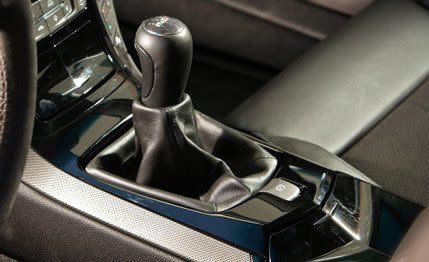
The CTS-V’s shift lever (above) is supposed to match the delightful faux-suede steering wheel (below), but we had to cope with a leather knob on our preproduction test car.
____________________________________________________
Aside from drag races, however, the CTS-V is user-friendly. That low-end torque means you can let out the clutch in first gear without even touching the gas. Tight steering, solid brakes, and a linear throttle combine for easy maneuvering along cramped European two-laners. The Cadillac transitions progressively from routine grocery-run mode to maximum attack, a characteristic that gives the driver supreme comfort and confidence.
And speaking of comfort, the Cadillac has the best ride of the group. Much credit goes to the Delphi-supplied magnetorheological shock absorbers, which we seem to love in every car they turn up in. In the CTS-V, it translates to that perfect balance between ride firmness and compliance. This is most evident on the autobahn, where the CTS-V sticks fervently to the road and exhibits none of the high-speed skittishness of the E63 or the XFR. And should you have the running room, the Caddy will smoke its rivals to a drag-limited top speed of 191 mph.
Perhaps the CTS-V has taken smoothness a little too far, because the front end doesn’t seem as responsive as that of the Mercedes. There’s no slack in the steering, but the nose doesn’t change direction with the precision of the Benz. The Caddy is more of a rhythm car, transitioning from left to right with perfect meter but underwhelming in single hairpins. The shifter lever feels a little isolated as well, but that might have something to do with taking the abuse of all those pound-feet without a hint of grinding. Our only serious driverly complaint is that for a car so finely tuned, the pedals are lined up to make heel-and-toe downshifting difficult to accomplish.
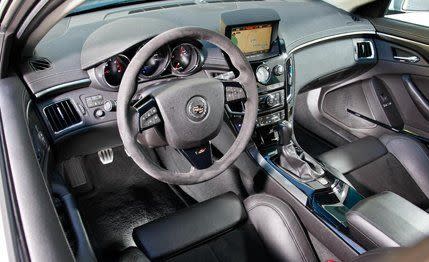
As with the rest of the group, the Caddy’s interior is largely unchanged compared with its lesser brethren. Chief alterations in the CTS-V are the optional Recaro seats, which are sports-car snug and adjustable in every dimension (including thigh bolsters), and an optional fake-suede-covered steering wheel that summons GT-racing fantasies every time we touch it. And the fit of the interior earned unanimous praise—would you believe the CTS-V has smaller panel gaps than the Benz? The only specters from GM’s past are the chintzy map lights. The back seats are the least comfortable of the group, where even a low bench can’t make up for a lack of headroom. The scalp-grazing roofline isn’t the only casualty of the styling; the tall trunklid and giant C-pillars left us wishing for a backup camera.
With the $35,780 you’d save over the E63’s price, you can back into a lot of parking-lot pylons before you’d start to care. And that the Cadillac achieves so much performance for so much less cash illustrates that, in only its second generation, the CTS-V is rapidly catching up to ze Germans.
In a September comparison test, we faulted a Mercedes E350 for having an overwhelmed engine and numb steering, as well as understeer-prone, roll-heavy handling that plopped it in last place. Suffice it to say that Mercedes has addressed those faults adequately in the E63 AMG.
First is the familiar 6.2-liter engine, now mated to a seven-speed automatic with a ZF-supplied wet-plate clutch pack in lieu of a torque converter, which is the same arrangement as in the SL63. In this application, the V-8 puts out 11 more horsepower than did the previous E63. We could (and did, actually) listen to it run up to its 7200-rpm redline all day..

For all the praise we could heap on the engine, the transmission deserves some, too. In sport plus or manual mode, the two quickest-shifting schemes, gearchanges snap off almost instantaneously. It also features the “race start” launch-control mode, which maximizes acceleration runs by eliminating excessive wheelspin.
We were surprised, though, to find out that launch control and lightning shifts make the E63 only 0.1 second quicker through the quarter-mile compared with its predecessor. Still, the 4.0-second run to 60 mph and the 12.5-second quarter-mile are only a tick behind a Porsche 911 Carrera S.
The other big change to the E63 involves its front suspension, which is widened 2.2 inches in track and has adopted coil springs. Air springs remain at the rear and let off a flatulent pfft at regular intervals when the E63 is parked in the sun. The revised tuning takes out the wallow in the E-class and trades it for a near-perfect handling balance, at least with the adjustable dampers set in sport or sport plus mode. The Benz managed the best skidpad grip, 0.92 g, and finished second in the lane change. Despite carrying the biggest percentage of weight over its front axle, the E63 changes direction with the same immediacy as its fast-shifting transmission. Germany’s roads are unbelievably smooth, although a few places, such as a cobblestone village center, reveal that the E63 can be jarringly stiff. We did find that the comfort setting takes some of the bite out of the rigid ride, although the sportier settings are recommended for any cornering. What the Benz gives up to the Caddy in comfort, though, it makes up for in responsiveness.
____________________________________________________
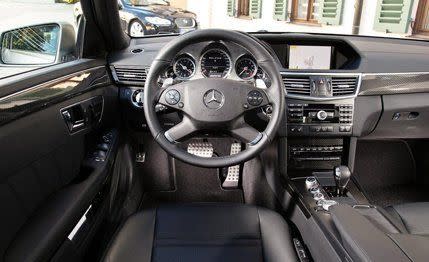
We doubt that the carbon-fiber interior trim, which looks all of its $2550 cost, has any effect on curb weight. Still, this Euro-market car is 153 pounds lighter than the previous E63 we tested in the U.S.
____________________________________________________
Switching the E63 through its myriad settings is fairly easy, even for the gadget averse. There’s no fiddling through on-screen menus; all buttons are clearly laid out next to the shift lever: transmission, stability control, and suspension. A fourth button brings up the driver’s custom combination and is programmed by holding it down for a few seconds.
The rest of the E63’s interior is arranged with utter simplicity—perhaps a little too much, as we’d prefer additional gauges instead of an oversized clock in the instrument cluster. Still, all the controls are well placed, and the relatively low cowl helps visibility. The back seat was by far the most comfortable of the bunch—remember that lesser versions of the E-class serve as taxicabs in many parts of the world—and deemed the only second row we’d pick for a trip of more than a few hours. Mercedes sweated the details not just for the driver but all passengers as well.
The details come at a big price, which brings us to the brakes. Absent of any fade and free of any squeaking (a typical carbon-ceramic-brake bugaboo), the E63 nonetheless took the longest—168 feet—to stop from 70 mph. They are good enough that we can say they’re among the most natural-feeling brakes of this type we’ve experienced, but it’s not clear that they are worth the expected $8000-to-$10,000 price tag.
Without the brakes, the E63 still commands a price that will get you into some very serious sports cars. Then again, the E63 is a serious sports car in its own right. As a former colleague once said, “It’s two cars for the price of two.”
You Might Also Like

